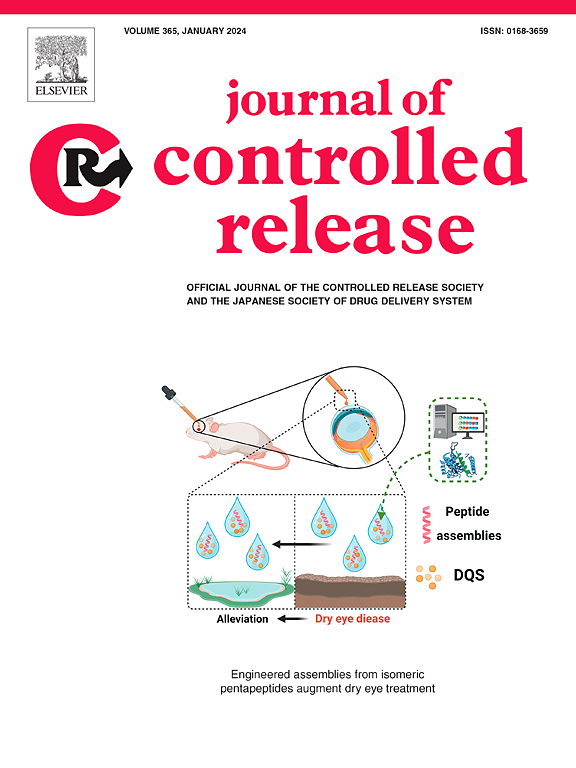纳米药物介导的巨噬细胞极化增强去铁胺在乳腺癌免疫治疗中的缺铁作用。
IF 10.5
1区 医学
Q1 CHEMISTRY, MULTIDISCIPLINARY
引用次数: 0
摘要
以铁代谢为靶点干扰肿瘤细胞生理功能的治疗策略已成为癌症治疗的重要途径。去铁胺(DFOM)是一种有效的fda批准的铁螯合剂,可主动清除细胞中的铁,诱导铁相关功能障碍。然而,它的使用受到脱靶毒性和肿瘤细胞先天代谢代偿能力的极大限制。为了解决这些挑战,在这里,我们开发了一种易于使用的锰掺杂磷酸钙矿化纳米颗粒,装载了DFOM(称为BSA@MnCaP@DFOM)。这些纳米颗粒通过激活toll样受体4 (TLR4)途径将肿瘤相关巨噬细胞极化为M1表型,从而切断其对肿瘤细胞的铁供应。这促进了DFOM的铁消耗效应,降低了铁蛋白重链1 (FTH1)的表达,破坏了铁代谢,并有效地诱导了高度铁依赖性4 T1乳腺癌细胞的线粒体功能障碍。因此,治疗触发肿瘤细胞的免疫原性细胞死亡,引发强大的抗肿瘤T细胞免疫反应。结合免疫抑制微环境的缓解,实现肿瘤抑制(72.5 %的抑制率)。总之,我们的纳米颗粒为铁代谢破坏介导的乳腺癌免疫治疗提供了一个有希望的策略。本文章由计算机程序翻译,如有差异,请以英文原文为准。

Nanomedicine-mediated macrophage polarization enhances the iron-depleting effect of desferrioxamine for breast cancer immunotherapy
Therapeutic strategies targeting iron metabolism to disturb the physiological functions of tumor cells have emerged as promising avenues in cancer treatment. Deferoxamine (DFOM) is an effective FDA-approved iron chelator that actively eliminates iron from cells, inducing iron-related dysfunction. However, its use is considerably limited by off-target toxicities and the innate metabolic compensatory capacity of tumor cells. To address these challenges, herein, we developed a facile manganese-doped calcium phosphate mineralized nanoparticle loaded with DFOM (termed BSA@MnCaP@DFOM). These nanoparticles polarized tumor-associated macrophages to M1 phenotype via activating Toll-like receptor 4 (TLR4) pathway, thereby cutting off their iron supply to tumor cells. This promoted the iron depletion effect of DFOM, reduced ferritin heavy chain 1 (FTH1) expression, disrupted iron metabolism, and efficiently induced mitochondrial dysfunction in the highly iron-dependent 4 T1 breast cancer cells. Consequently, the treatment triggered immunogenic cell death in tumor cells, eliciting a robust antitumor T cells immune response. Combined with mitigation of the immunosuppressive microenvironment, tumor suppression was achieved (72.5 % inhibition rate). In summary, our nanoparticles offer a promising strategy for iron metabolism disruption-mediated breast cancer immunotherapy.
求助全文
通过发布文献求助,成功后即可免费获取论文全文。
去求助
来源期刊

Journal of Controlled Release
医学-化学综合
CiteScore
18.50
自引率
5.60%
发文量
700
审稿时长
39 days
期刊介绍:
The Journal of Controlled Release (JCR) proudly serves as the Official Journal of the Controlled Release Society and the Japan Society of Drug Delivery System.
Dedicated to the broad field of delivery science and technology, JCR publishes high-quality research articles covering drug delivery systems and all facets of formulations. This includes the physicochemical and biological properties of drugs, design and characterization of dosage forms, release mechanisms, in vivo testing, and formulation research and development across pharmaceutical, diagnostic, agricultural, environmental, cosmetic, and food industries.
Priority is given to manuscripts that contribute to the fundamental understanding of principles or demonstrate the advantages of novel technologies in terms of safety and efficacy over current clinical standards. JCR strives to be a leading platform for advancements in delivery science and technology.
 求助内容:
求助内容: 应助结果提醒方式:
应助结果提醒方式:


